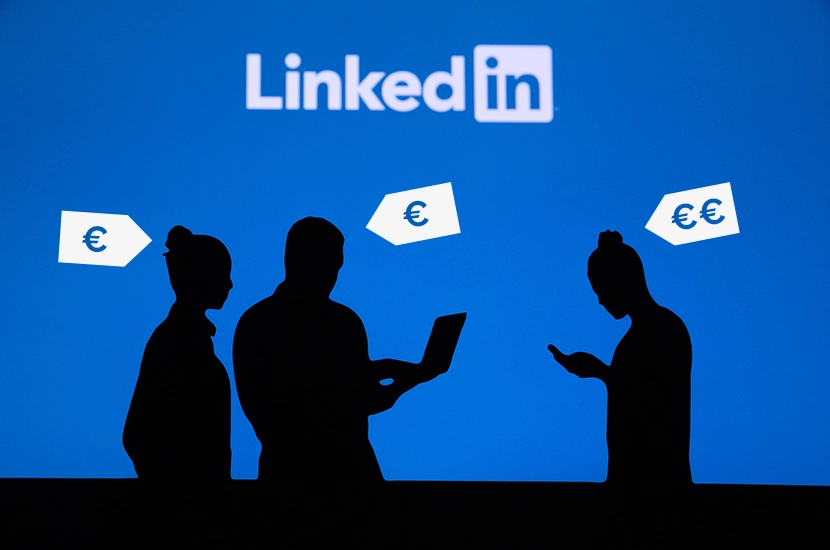For B2B companies, LinkedIn Ads is the most powerful paid acquisition lever, but also the most demanding. Its reputation as an expensive platform is well established. In this ecosystem, LinkedIn’s Cost Per Lead (CPL) should not be a cost you incur, but a result you drive. However, it’s not so easy for B2B marketing teams to measure it, and this difficulty can cost them thousands of euros. Relying solely on the Campaign Manager’s raw figures ignores hidden costs, and can lead to budgetary decisions based on an incomplete view of profitability. In this article, the experts at our LinkedIn Ads agency analyze the factors influencing CPL and deliver concrete strategies for transforming your spend into a predictable, profitable growth engine.
Cost per Lead (CPL) on LinkedIn Ads: definition
When it comes to setting up a lead generation campaign on LinkedIn, one of the first questions that comes to mind is: what will my Cost Per Lead be? Cost per lead, or CPL, is the indicator that measures the average amount you spend to acquire a lead via your advertising campaigns. In the B2B world, where sales cycles are long and the value of each customer is high, tracking CPL is fundamental to guaranteeing a positive return on investment (ROI). A controlled CPL is the sign of a sound advertising strategy, where targeting, message and offer are perfectly aligned with audience expectations.
The calculation of CPL is simple in theory: CPL = Total budget spent / Number of leads generated.
However, the reality of costs on LinkedIn is complex and varies enormously. CPL is estimated to range from €100 to €400. That’s a wide range! But it shows that a rigorous approach and well-executed optimization strategies can significantly reduce costs. To understand how to achieve the best possible PLC, it’s essential to analyze the many factors that influence it.
6 factors that influence your Cost per Lead on LinkedIn
The CPL displayed in your Campaign Manager is the end product of seven interdependent variables. Mastering just one can reduce your costs by 15%. By mastering them all, you move from being a “spendthrift” to a “strategic investor”. Understanding and mastering each of these levers is the key to effectively managing your advertising budget.
Your business sector: your first cost variable
The competitiveness of your sector has a direct impact on costs. The more advertisers there are targeting the same audience as you, the higher the bids, and the higher the CPL. Some sectors are notoriously more expensive, due to high customer lifetime value or regulatory constraints. For example, SaaS solutions, HR solutions or FinTech.
Precise audience targeting
Targeting is undoubtedly the most decisive factor in your success on LinkedIn. The platform offers unique professional criteria (position, sector, seniority, company size, skills) that enable surgical precision. However, this precision must be handled with care.
- Over-targeting dilutes your budget by delivering your ads to irrelevant profiles, driving down your conversion rate.
- Targeting too narrowly can drive up costs due to increased competition for a small audience, and limit the algorithm’s ability to optimize delivery.
To optimize your spending, also consider using the opt-out options to prevent your ads from being shown to your employees, competitors or existing customers.
The trap to avoid: believing that LinkedIn’s recommendation of an audience of >50,000 people is a golden rule. For ABM campaigns or high-value niche offers, an audience of 5,000 ultra-qualified profiles will always be more profitable.
The advertising format
The format of your ad has a direct influence on engagement, conversion rate and, consequently, CPL. Each format meets different objectives.
Lead Gen Forms: This format often has a lower CPL because it reduces friction by pre-filling information.
There’s a common misconception that Lead Gen Forms generate low-quality leads. The reality is that they generate leads with low immediate intent. The nuance is crucial: these prospects are perfectly qualified according to your targeting criteria, but require further nurturing, not hasty disqualification.
- Sponsored Content (Single Image & Document Ads): these formats, especially when combined with Lead Gen forms, frequently produce the lowest CPLs.
- Video Ads: video is experiencing explosive growth. While highly effective at capturing attention, its CPL needs to be closely monitored.
- Conversation Ads: highly effective for Account-Based Marketing (ABM) campaigns, they have a higher “equivalent CPC”.
The choice of a low-friction Lead Gen form has a direct impact on the next factor: the value of the offer. A “light” offer (ebook) coupled with a simple form will generate a high volume of top-funnel MQLs (Marketing Qualified Leads), while a “heavy” offer (demo) will require a more robust landing page to justify the commitment requested.
Offer and quality of content
The perceived value of what you offer in exchange for a prospect’s contact details (white paper, webinar, demo) is a direct driver of the conversion rate.
- Low-friction offers: downloading an e-book or an industry study generally generates lower CPLs. Content based on recent data or a topical angle achieves particularly high engagement rates.
- High-friction offers: a demo request is a much more engaging step. The CPL will logically be higher, but the leads generated will be far more qualified.
Auction strategy
The choice between manual and automatic auctions has a direct impact on your costs. We recommend starting with manual or cost-cap auctions. This approach allows you to establish a performance base and retain full control over initial expenditure. Once performance has stabilized, automatic auctions can be considered.
The post-click experience
All your efforts can be undone by a poor post-click experience. Whether the user lands on a landing page or opens a Lead Gen form, this final step is crucial. A slow landing page, a confusing message, or a form that’s too long will cause your conversion rate to plummet and, consequently, your CPL to explode.
5 concrete strategies to reduce your CPL on LinkedIn
Knowing is good. Acting is better. Here are five surgical strategies for regaining control of your PLC, each with the potential to fund your next campaign with the savings you make.
Continuous A/B testing
Optimization is not a one-off event, but a continuous process. A/B testing is the most rigorous method for sustainably improving your performance.
- Create several variations: launch each campaign with 2 to 4 different ad creatives to quickly identify the best performers.
- Isolate variables: for reliable results, test only one element at a time. Start with visuals, then titles, and finally body text.
- Set up a refresh cycle: the performance of an ad (measured by its CTR) generally declines after two weeks. Adopt a 14-day cycle for renewing creatives.
Hyper-targeting: aim for relevance, not size
Rather than overlaying broad criteria with “OR” logic, use skill stacking with “AND” rules to create ultra-relevant audiences.
For example, for a webinar on SEO and the customer journey, target only profiles with skills in both SEO and the customer journey. Such an approach has been proven to achieve a form conversion rate of 40%, compared with an average of 13% for broader targeting.
Mastering your manual bidding strategy
For total control over your costs, opt for manual Cost-per-Click (CPC) bidding when launching your campaigns. Adopt the concept of “minimum viable CPC”: start with a low bid, then gradually increase it until you reach the desired volume of impressions, without overpaying.
It’s also important to demystify the idea that a low bid diminishes audience quality. Unlike intent-based platforms like Google Ads, quality on LinkedIn is defined by upstream targeting, not by bidding competition. Once the audience is defined, all members match your criteria; a lower bid simply positions you differently in the ad rotation, without altering the intrinsic qualification of the target.
Optimize the form to reduce friction
Every added form field is a tax on your conversion rate. Friction should be kept to a minimum, especially on mobile.
- Minimize mandatory fields: limit yourself to 3 or 4 fields maximum. Only ask for information that is strictly necessary.
- Avoid manual fields: as far as possible, use fields that LinkedIn can pre-fill automatically from your profile data.
- Justify the request for sensitive information: asking for a telephone number or sales figures can create hesitation. If it’s essential, explain why.
Implement Advanced Tracking with the Conversion API (CAPI)
In a world where third-party cookies are disappearing, LinkedIn’s Conversion API (CAPI) is becoming a major competitive advantage. This tool sends conversion data from your server directly to LinkedIn, offering more reliable tracking. Advertisers using it see a drop of around 20% in Cost Per Acquisition (CPA), and can capture 20% more touchpoints in the buying journey.
How to calculate your true Cost per Lead on LinkedIn?
Relying solely on the advertising spend displayed in LinkedIn Campaign Manager is a mistake that can lead to poor decisions. This view is incomplete, because it ignores the “invisible” but very real costs associated with processing each lead. For intelligent budget allocation, you need to calculate your refined CPL.
Here’s a simple three-step method:
- Step 1: Media cost per MQL. This is your starting point, the standard calculation: budget spent / number of Marketing Qualified Leads (MQLs) generated.
- Step 2: Add processing costs. Every MQL generates operational costs. Include human time (lead qualification, calls, etc.) and tool costs (CRM, automation), smoothed out per lead. For example, a lead processed for 8 minutes by a SDR (Sales Development Representative) whose hourly cost is €40 comes to €5.33 per lead.
- Step 3: Weight by withdrawal rate. A validated MQL is not yet a guaranteed appointment. Many prospects don’t show up for their scheduled appointment. Include this loss in your calculation. The corrected formula becomes: Total cost per MQL = (media cost + processing cost) / (1 – cancellation rate)
A channel with an attractive media CPL but a high opt-out rate may in reality be prohibitively expensive. By adopting this refined calculation, you no longer compare channels on their apparent cost of acquisition, but on their actual cost per opportunity. This makes it possible to justify higher investments on channels like LinkedIn, which may generate more expensive MQLs but have a much lower opt-out rate, making them ultimately more profitable.
CPL on LinkedIn, a strategic investment
The CPL on LinkedIn is certainly higher, but this reality hides a fundamental truth: value lies in quality, not quantity. Precise targeting, combined with a professional context, makes LinkedIn an extremely profitable investment when managed strategically. CPL is not an inevitability, but a variable that you can and must influence.
Here’s your action plan to transform your LinkedIn campaigns into a real engine of growth:
- Audit your current PLCs against benchmarks to identify priorities.
- Identify the factors that have the greatest impact on your costs (targeting, format, offer).
- Run methodical A/B tests on a single variable at a time.
- Calculate your “real CPL” to assess the real profitability of each channel.
By adopting this structured, analytical approach, you’ll stop “spending” on LinkedIn and start “investing” in it intelligently, with tangible, sustainable ROI. To optimize your presence on LinkedIn Ads, don’t hesitate to call on our experts.




